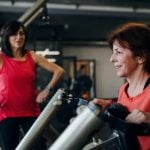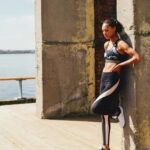How are workout pants supposed to fit? Well, the right fit is crucial for not only your comfort but also your performance during exercise. Ill-fitting workout pants can lead to discomfort, distractions, and even potential wardrobe malfunctions. Understanding the importance of well-fitting workout pants is essential for a successful and enjoyable workout routine.
When it comes to workout pants, there are various styles to choose from, such as leggings, joggers, and more. Each style serves a different purpose and offers unique features that cater to different types of activities. Knowing the differences between these styles can help you select the best option for your specific fitness needs and personal preferences.
Additionally, finding the perfect fit in terms of length, waistband style, fabric type, and crotch area is key to ensuring your workout pants enhance your performance rather than hinder it. By paying attention to these factors and avoiding common fit issues like sagging or see-through materials, you can feel confident and comfortable during your workouts.
Stay tuned for valuable tips on trying on workout pants and making sure they fit perfectly for a boost in both performance and self-assurance.
Understanding the Different Styles of Workout Pants
When it comes to workout pants, there are various styles to choose from that cater to different preferences and activities. Leggings are a popular choice for many individuals due to their form-fitting design that allows for maximum flexibility during workouts.
They often come in different lengths, including full-length and cropped, to suit different needs and preferences. Joggers, on the other hand, provide a more relaxed fit with a tapered leg design, making them a great option for activities like yoga or Pilates.
The Right Length for Your Workout Pants: Full-Length vs. Cropped
As you consider how workout pants should fit, one important factor to take into account is the length of the pants. Full-length leggings provide coverage from waist to ankle, which can be great for cooler weather or if you prefer more coverage during your workouts.
On the other hand, cropped leggings end around mid-calf or just above the ankle, offering a more breathable option for warm-weather activities or if you prefer less fabric around your ankles during workouts.
Finding the Perfect Waistband for Your Body Type: High-Rise vs. Mid-Rise vs. Low-Rise
Another crucial aspect of ensuring that your workout pants fit correctly is finding the right waistband style for your body type. High-rise waistbands typically sit at or above the belly button and provide compression and support around the midsection, making them an excellent choice for those who want extra tummy control.
Mid-rise waistbands sit at the natural waistline and offer a balance between coverage and comfort. Low-rise waistbands sit below the navel and provide a more relaxed fit that some may find comfortable during low-impact activities such as walking or weight training.
The Right Length for Your Workout Pants
When it comes to workout pants, finding the right length is crucial to ensure both comfort and functionality during your fitness routines. The debate between full-length and cropped workout pants is a common one among active individuals, each offering its own set of benefits depending on the type of exercise you prefer.
To help you understand how workout pants are supposed to fit in terms of length, let’s break down the differences between full-length and cropped styles:
- Full-Length Workout Pants: These pants typically extend all the way to your ankles, providing maximum coverage and warmth during colder months. They are ideal for activities like running, yoga, or weightlifting where you want full leg coverage and protection.
- Cropped Workout Pants: Cropped pants stop somewhere between mid-calf and the ankle, allowing for more breathability and freedom of movement. They are great for high-intensity workouts like HIIT or spin classes where you need more ventilation to stay cool.
When considering how workout pants should fit in terms of length, think about the type of exercises you’ll be doing and the climate you’ll be in. Full-length pants may be better suited for outdoor winter runs, while cropped pants are perfect for hot yoga sessions. Ultimately, prioritize comfort and functionality when choosing between full-length and cropped styles to optimize your workout performance.
Finding the Perfect Waistband for Your Body Type
Choosing the right waistband for your body type is essential when it comes to finding the perfect fit for workout pants. High-rise, mid-rise, and low-rise waistbands each offer different benefits depending on your preferences and comfort level.
High-rise workout pants are designed to sit above your natural waistline, providing extra coverage and support for your midsection. This style is great for those who prefer maximum coverage and compression during their workouts. On the other hand, mid-rise pants typically sit just below the belly button, offering a balance between coverage and comfort. They are a versatile option that works well for various body types.
Low-rise workout pants sit lower on the hips, making them ideal for individuals who prefer a more relaxed fit or those with shorter torsos. These pants are great for activities that require a wide range of motion, such as yoga or Pilates. Ultimately, the best waistband style for you will depend on your personal preference and how you like your workout pants to fit.
When considering how workout pants are supposed to fit, keep in mind that the waistband should feel snug but not constricting. It should stay in place during movement without digging into your skin or causing discomfort. Trying on different styles and sizes can help you determine which waistband height suits you best and provides the most flattering fit for your body type.
| Waistband Style | Description |
|---|---|
| High-Rise | Sits above the natural waistline, offers maximum coverage and support. |
| Mid-Rise | Sits just below the belly button, provides a balance between coverage and comfort. |
| Low-Rise | Sits lower on the hips, ideal for individuals who prefer a more relaxed fit. |
Fabric Matters
When it comes to workout pants, the fabric plays a significant role in both performance and comfort. Understanding the different properties of fabrics can help you choose the right pair that suits your needs. Here are some key factors to consider when assessing workout pant fabrics:
- Moisture-wicking: Look for materials like polyester, nylon, or spandex that are designed to draw sweat away from your skin to keep you dry and comfortable during your workout.
- Compression: Some workout pants offer compression features that can provide support for your muscles, aid in recovery, and improve blood circulation. Compression fabric is typically tighter than regular materials but should still allow for flexibility and movement.
- Breathability: Fabrics with breathability properties such as mesh panels or perforations help regulate body temperature by allowing airflow. This is especially important during intense workouts or hot weather conditions to prevent overheating.
Choosing workout pants with the right fabric can enhance your overall exercise experience by keeping you cool, dry, and supported throughout your activities. Whether you prefer moisture-wicking leggings for yoga or compression joggers for running, understanding these fabric properties can help you make an informed decision on how your workout pants are supposed to fit.
The Importance of the Right Fit in the Crotch Area
When it comes to workout pants, one of the key areas to pay attention to is the fit in the crotch area. The right fit in this region is crucial for both comfort and performance during your workouts. Ill-fitting workout pants in the crotch area can lead to chafing, discomfort, and even hinder your range of motion while exercising. So, how are workout pants supposed to fit in the crotch area?
Firstly, workout pants should have enough room in the crotch area to allow for movement without being too constricting. When trying on workout pants, make sure there is no excess fabric that could lead to sagging or bunching up. At the same time, you don’t want the pants to be too tight in the crotch as this can also cause discomfort and restrict your movements. Look for a balance between a snug fit and enough room for flexibility.
Additionally, pay attention to where the seams fall in the crotch area. Seams that rub against your skin or cause irritation can be extremely uncomfortable during a workout. Opt for workout pants with flatlock seams or minimal seam construction in the crotch area to minimize any potential chafing. Remember, finding workout pants that provide a comfortable and well-fitted crotch area is essential for ensuring you can move freely and confidently during your workouts.
Avoiding Common Fit Issues
When it comes to workout pants, fit is crucial not just for comfort but also for performance. Ill-fitting workout pants can lead to common issues like sagging, rolling, and see-through materials, which can be distracting and even hinder your workout. So, how are workout pants supposed to fit to avoid these pitfalls?
Avoiding Sagging
One of the most common fit issues with workout pants is sagging. This can happen if the pants are too big or if the fabric lacks proper elasticity. To prevent sagging, make sure your workout pants have a snug but comfortable fit around your waist and hips. Look for styles with a high-rise waistband, as they provide more support and help keep the pants in place during movement.
Preventing Rolling
Another fit issue that many people encounter with workout pants is rolling at the waistband or hems. This can be frustrating and distracting, especially during intense workouts. To avoid rolling, opt for workout pants with a wide and sturdy waistband that sits comfortably on your body without digging in. Additionally, choose leggings or joggers with flat seams and secure hems that won’t curl up during activity.
Avoiding See-Through Materials
One of the most embarrassing fit issues you can face with workout pants is when they become see-through during squats or stretches. This happens when the fabric is not opaque enough to provide adequate coverage.
To prevent see-through materials, test the opacity of your workout pants by bending over in front of a mirror or doing a squat test before purchasing them. Look for moisture-wicking fabrics with a good amount of compression to ensure full coverage during any movement.
By paying attention to these details and making sure your workout pants fit properly around your waist, hips, crotch area, and legs, you can avoid common fit issues like sagging, rolling, and see-through materials. Remember that well-fitting workout pants not only enhance your performance but also boost your confidence in every gym session or outdoor exercise routine.
Tips for Trying on Workout Pants and Ensuring They Fit Perfectly
When it comes to workout pants, the fit is key to not only your comfort but also your performance during exercise. So, how are workout pants supposed to fit? The answer lies in finding a balance between snugness and freedom of movement. The waistband should sit comfortably on your waist without digging in or sliding down during activity. Additionally, the pants should not be too tight or too loose around the hips and thighs, allowing you to move effortlessly.
One essential tip for trying on workout pants is to always test them by doing a few movements such as squats, lunges, or stretches. This will give you a better idea of how the pants will perform during your workouts.
Make sure the fabric is flexible enough to stretch with your body without becoming see-through or restrictive. You should also pay attention to any sliding or bunching that may occur when you move around – this can indicate that the fit is not right for your body shape.
Another important aspect to consider when trying on workout pants is the length. Depending on your preference and the type of exercise you’re doing, you might opt for full-length pants or cropped ones. Full-length leggings are perfect for activities like yoga or running outdoors in cooler weather, while cropped leggings offer more breathability during intense workouts. Ultimately, choosing the right length comes down to personal comfort and function.
| Aspect | Consideration |
|---|---|
| Fit in the waistband | Comfortably snug without digging in |
| Length | Full-length vs Cropped based on activity and preference |
| Movement test | Do squats, lunges, stretches to assess flexibility and fit |
Conclusion
In conclusion, the key to feeling confident and comfortable during your workouts lies in wearing well-fitted workout pants. Understanding the different styles available, from leggings to joggers, and choosing the right length for your body can make a world of difference in how you feel while exercising. Knowing what waistband works best for your body type, whether it’s high-rise, mid-rise, or low-rise, can also impact both your comfort and performance.
Fabric choice is another crucial factor in ensuring that your workout pants fit correctly. Look for materials with moisture-wicking properties, compression features, and breathability to enhance your overall experience. Paying attention to the crotch area fit can prevent any unnecessary discomfort or chafing during physical activity.
By avoiding common fit issues like sagging, rolling waistbands, or see-through fabrics, you can focus on your workout without any distractions. Remember to try on workout pants before purchasing them and take the time to assess how they feel and move with your body.
Embracing the confidence that comes with well-fitting workout pants will not only elevate your performance but also boost your self-assurance in every fitness endeavor. So next time you wonder “how are workout pants supposed to fit,” remember these tips and choose apparel that makes you feel empowered and ready to tackle any challenge at the gym.
Frequently Asked Questions
Should Workout Pants Be Tight?
Workout pants being tight is a matter of personal preference and comfort. Some individuals prefer tight workout pants for support and compression, while others may find them restrictive. It ultimately depends on what feels best for you during your workouts.
Should You Size Up or Down in Activewear?
When it comes to sizing in activewear, it’s essential to consider the type of activity you’ll be engaging in. For high-impact activities like running, some people prefer sizing down for a snug fit that minimizes movement. However, for activities like yoga or weightlifting, sizing up may provide more flexibility and comfort.
How Do I Know if My Gym Leggings Are Too Small?
You can tell if your gym leggings are too small if they feel excessively tight around your waist, thighs, or calves. Signs of leggings being too small include fabric stretching to its limit, restricted movement during exercises, and an uncomfortable fit that leaves marks on your skin after wearing them.

Passionate about providing useful information to anyone with an interest in the field of Personal Training, I strive to pass on to our readers quality information and to answer any questions about Personal Trainers, the work they do and how to become one.





